Why did the Tory party choose as leader the charisma-deficient Liz Truss who, one month into the job, is the most unpopular prime minister in recent history?
Why did King Charles allow himself to be complicit in an unfitting jibe at the DUP leader when he greeted Michelle O’Neill on one of his first duties as monarch?
Why did Netflix think its travesty of the life of Marilyn Monroe would boost its declining numbers?
Because, apparently, the western world is still transfixed by all things blonde: the Netflix title is simply “Blonde”.
Oscars 2025: Who will win and who should win? Ireland has just one chance
Life without children: ‘I’d want the investment my mother had, but I don’t have it in me. I don’t have the grá for it’
Mark O’Connell: How ‘non-player character’ became a potent insult for the digital age
Athletes running abroad: why more Irish medal hopes are being driven by foreign coaches
Less a hair colour than a state of mind, nobody nowadays cares whether gentlemen prefer them, and it’s arguable whether they have more fun. But, female or male, they certainly seem to have more power. Donald Trump and Boris Johnson are blond and neither have gone away, you know.
If O’Neill was a less high-octane blonde would King Charles have begun his reign with a meet and greet gaffe, which one way or another, could have a lasting impact on one of his devolved governments?

Holding her hand for twice as long as normal protocol dictates, flattering her outrageously – “all that skill and ingenuity” – and chatting animatedly about when they last met, could be attributed to a new more relaxed monarchy. Or an older, wilier briefing.
But as a whole, it added up to a boundaries breach that made him party to a cheap jibe at Jeffrey Donaldson by the Speaker of the Northern Ireland Assembly, Alex Maskey. Donaldson’s grace under pressure, observing protocols and welcoming the king, may yet hoist them on their own petard.
When, a few days later, O’Neill sat, hatless at the queen’s funeral, in Westminster Cathedral, the cameras of the world found her easily: the shock of blonde hair providing its own “key” light.
[ Blonde review: Marilyn Monroe is still waiting for the justice she deservesOpens in new window ]
High visibility is the ostensible lure of blonde hair. It was also a potent symbol of desirability in western culture. Academics have identified the “blonde paradox”, a conflict between desire and derision: dyed blonde hair was considered transgressive as it indicated an ambition for sexual power.
Well before Hollywood, Yeats addressed the ineffable power of blonde in his poem for Anne Gregory: “Never shall a young man, Thrown into despair, By those great honey-coloured ramparts at your ear, Love you for yourself alone . . .”
Monroe, the most iconic blonde of the 20th century, would have been aware of these lines: she loved Yeats – even reading him aloud at dinner parties. According to photographer Eve Arnold, she carried a battered copy of Joyce’s Ulysses in her car, regularly dipping into it – possibly the best way to read it. She loved poets and poetry and wrote her own, which is suffused with loneliness.
None of this could be gleaned from Blonde, the much-vaunted Netflix movie. Instead of the complex archetypical blonde who used everything she had to transcend patriarchal boundaries, we get a one-dimensional abuse victim. Everyone knows she longed to know her real father, that her mother had mental health problems and the misogyny of studio system was abominable. But the giant #MeToo cartoon character of this horror noir denies all of Monroe’s purity, her triumph over her own troubled childhood and her hard work to become an artist.
Every encounter with a man is exploitative or violent. When she died, among her effects were notes on the people she most admired, with reasons attached. After Eleanor Roosevelt came John F Kennedy and his brother. In the movie, JFK is portrayed as an Oval Office Weinstein. And her luminous, white hot “Happy Birthday Mr President”, that eternal anthem for two doomed icons, disappears into a ghastly sordid backstory for which there is no evidence.
Monroe identified with people’s struggles. Truss says she does too. But her imperious ‘Get them removed’ response to the two young women Greenpeace activists at the Tory party conference shows she’s no Monroe
The Kennedy government was already tackling labour and civil rights reforms when she sang that song. And only a few months later, president Kennedy, as Joe Biden reminded us last week, skilfully averted a direct threat of nuclear disaster. “We have not faced the prospect of Armageddon since Kennedy and the Cuban missile crisis,” he said. For 13 terrifying days, the world stood on the brink of annihilation as Kennedy held his nerve: rejecting a full-scale assault on Cuba, his naval blockade forced the Soviets to dismantle the missiles and take them back to Russia.
This was the Kennedy that Monroe admired. Because unlike the passive wreck of the movie, her identity as a woman was one of agency and power. She started her own production company. She used her celebrity to boost her friend Ella Fitzgerald’s career in Hollywood at a time when black singers did not get headlining gigs. She was brave politically, stoutly supporting Arthur Miller when he was persecuted by senator Joe McCarthy’s House of Un-American Activities. She befriended many writers who were blacklisted by McCarthy for their communist associations. Outspoken in support of labour, she herself was investigated by the FBI.
Monroe identified with people’s struggles. Truss says she does too. But her imperious “Get them removed” response to the two young women Greenpeace activists at the Tory party conference shows she’s no Monroe. Climate change is under the bus, along with her chancellor and her promises to the DUP. Donaldson’s exhortation last weekend to his party conference – “We can be Northern Irish and British… And yes, we can be Irish and British” – reveals a new breadth of vision and self-reliance. Whether he learned from the psalms or Machiavelli, he will not now lightly put his trust in princes. Or in blondes.
















